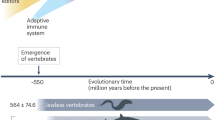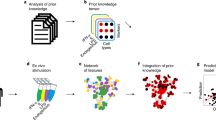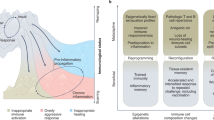Abstract
The recognition of immune epitopes is an important molecular mechanism of the vertebrate immune system to discriminate between self and non-self. Increasing amounts of data on immune epitopes are becoming available due to technological advances in epitope-mapping techniques and the availability of genomic information for pathogens. Organizing this data poses a challenge that is similar to the successful effort that was required to organize genomic data, which needed the establishment of centralized databases that complement the primary literature to make the data readily accessible and searchable by researchers. As described in this Innovation article, the Immune Epitope Database and Analysis Resource aims to achieve the same for the more complex and context-dependent information on immune epitopes, and to integrate this data with existing and emerging knowledge resources.
This is a preview of subscription content, access via your institution
Access options
Subscribe to this journal
Receive 12 print issues and online access
$259.00 per year
only $21.58 per issue
Buy this article
- Purchase on SpringerLink
- Instant access to full article PDF
Prices may be subject to local taxes which are calculated during checkout




Similar content being viewed by others
References
Rammensee, H., Bachmann, J., Emmerich, N. P., Bachor, O. A. & Stevanovic, S. SYFPEITHI: database for MHC ligands and peptide motifs. Immunogenetics 50, 213–219. (1999).
Giudicelli, V. et al. IMGT/LIGM-DB, the IMGT comprehensive database of immunoglobulin and T cell receptor nucleotide sequences. Nucleic Acids Res. 34, D781–D784 (2006).
Toseland, C. P. et al. AntiJen: a quantitative immunology database integrating functional, thermodynamic, kinetic, biophysical, and cellular data. Immunome Res. 1, 4 (2005).
Schonbach, C., Koh, J. L., Flower, D. R. & Brusic, V. An update on the functional molecular immunology (FIMM) database. Appl. Bioinformatics 4, 25–31 (2005).
Bhasin, M., Singh, H. & Raghava, G. P. MHCBN: a comprehensive database of MHC binding and non-binding peptides. Bioinformatics 19, 665–666 (2003).
Sathiamurthy, M. et al. Population of the HLA ligand database. Tissue Antigens 61, 12–19 (2003).
HIV Molecular Immunology 2005 (eds Bette T. M. et al.) LA-UR 06–0036 (Los Alamos National Laboratory, Theoretical Biology and Biophysics, Los Alamos, New Mexico, 2005).
Yusim, K. et al. Los Alamos hepatitis C immunology database. Appl. Bioinformatics 4, 217–225 (2005).
Peters, B. et al. The immune epitope database and analysis resource: from vision to blueprint. PLoS Biol. 3, e91 (2005).
Peters, B. et al. The design and implementation of the immune epitope database and analysis resource. Immunogenetics 57, 326–336 (2005).
Korber, B., LaBute, M. & Yusim, K. Immunoinformatics comes of age. PLoS Comput. Biol. 2, e71 (2006).
Braga-Neto, U. M. & Marques, E. T. Jr. From functional genomics to functional immunomics: new challenges, old problems, big rewards. PLoS Comput. Biol. 2, e81 (2006).
NIAID Category A, B and C Priority Pathogens. [online], http://www3.niaid.nih.gov/Biodefense/PDF/cat.pdf, (2007).
Vita, R. et al. Curation of complex, context-dependent immunological data. BMC Bioinformatics 7, 341 (2006).
Rubin, D. L. et al. National Center for Biomedical Ontology: advancing biomedicine through structured organization of scientific knowledge. Omics 10, 185–198 (2006).
Lefranc, M. P. et al. IMGT-ONTOLOGY for immunogenetics and immunoinformatics. In Silico Biol. 4, 17–29 (2004).
Sathiamurthy, M. et al. An ontology for immune epitopes: application to the design of a broad scope database of immune reactivities. Immunome Res. 1, 2 (2005).
Whetzel, P. L. et al. Development of FuGO: an ontology for functional genomics investigations. Omics 10, 199–204 (2006).
Harris, M. A. et al. The Gene Ontology (GO) database and informatics resource. Nucleic Acids Res. 32, D258–D261 (2004).
Diehl, A. D., Lee, J. A., Scheuermann, R. H. & Blake, J. A. Ontology development for biological systems: Immunology. Bioinformatics 31 January 2007 (doi: 10.1093/bioinformatics/btm029).
Cohen, A. M. & Hersh, W. R. A survey of current work in biomedical text mining. Brief Bioinform. 6, 57–71 (2005).
Jensen, L. J., Saric, J. & Bork, P. Literature mining for the biologist: from information retrieval to biological discovery. Nature Rev. Genet. 7, 119–129 (2006).
Miotto, O., Tan, T. W. & Brusic, V. Supporting the curation of biological databases with reusable text mining. Genome Inform. 16, 32–44 (2005).
Donaldson, I. et al. PreBIND and Textomy—mining the biomedical literature for protein-protein interactions using a support vector machine. BMC Bioinformatics 4, 11 (2003).
Yeh, A. S., Hirschman, L. & Morgan, A. A. Evaluation of text data mining for database curation: lessons learned from the KDD Challenge Cup. Bioinformatics 19 (Suppl. 1), 331–339 (2003).
De Groot, A. S. Immunomics: discovering new targets for vaccines and therapeutics. Drug Discov. Today 11, 203–209 (2006).
Peters, B. et al. A community resource benchmarking predictions of peptide binding to MHC-I molecules. PLoS Comput. Biol. 2, e65 (2006).
Moult, J. A decade of CASP: progress, bottlenecks and prognosis in protein structure prediction. Curr. Opin. Struct. Biol. 15, 285–289 (2005).
Blythe, M. J. & Flower, D. R. Benchmarking B cell epitope prediction: underperformance of existing methods. Protein Sci. 14, 246–248 (2005).
Greenbaum, J. A. et al. Towards a consensus on datasets and evaluation metrics for developing B-cell epitope prediction tools. J. Mol. Recognit. 20, 75–82 (2007).
Bui, H. H. et al. Predicting population coverage of T-cell epitope-based diagnostics and vaccines. BMC Bioinformatics 7, 153 (2006).
Beaver, J. E., Bourne, P. E. & Ponomarenko, J. V. EpitopeViewer: a Java application for the visualization and analysis of immune epitopes in the Immune Epitope Database and Analysis Resource (IEDB). Immunome Res. 3, 3 (2007).
Bui, H. H., Peters, B., Assarsson, E., Mbawuike, I. & Sette, A. Ab and T cell epitopes of influenza A virus, knowledge and opportunities. Proc. Natl Acad. Sci. USA 104, 246–251 (2007).
He, Y. et al. Mapping of antigenic sites on the nucleocapsid protein of the severe acute respiratory syndrome coronavirus. J. Clin. Microbiol. 42, 5309–5314 (2004).
Acknowledgements
We thank J. Ponomarenko and P. Bourne at the San Diego Supercomputer Center, who developed the Homology Mapping tool. This work was supported by the National Institutes of Health, USA.
Author information
Authors and Affiliations
Corresponding author
Ethics declarations
Competing interests
The authors declare no competing financial interests.
Related links
Rights and permissions
About this article
Cite this article
Peters, B., Sette, A. Integrating epitope data into the emerging web of biomedical knowledge resources. Nat Rev Immunol 7, 485–490 (2007). https://doi.org/10.1038/nri2092
Issue date:
DOI: https://doi.org/10.1038/nri2092
This article is cited by
-
Design of Vaccine Targeting Zika Virus Polyprotein by Immunoinformatics Technique
International Journal of Peptide Research and Therapeutics (2022)
-
Design of Monovalent and Chimeric Tetravalent Dengue Vaccine Using an Immunoinformatics Approach
International Journal of Peptide Research and Therapeutics (2021)
-
Proteasomes generate spliced epitopes by two different mechanisms and as efficiently as non-spliced epitopes
Scientific Reports (2016)
-
Computational approaches to identify common subunit vaccine candidates against bacterial meningitis
Interdisciplinary Sciences: Computational Life Sciences (2013)
-
Computer aided subunit vaccine design against pathogenic Leptospira serovars
Interdisciplinary Sciences: Computational Life Sciences (2012)



